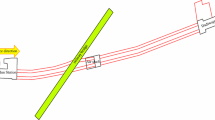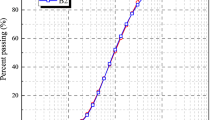Abstract
In urban tunneling with an earth pressure balance-tunnel boring machine (EPB-TBM), highly plastic clays or sticky clay containing fine-grained sediments makes tunneling conditions more difficult. The proper amount and consistency of the ground conditioning chemicals to be used for the excavation of these difficult or complex geological units are also controversial. Due to the lack of proper management and optimization of such chemical foaming agents in accordance with the excavation material and tunneling method, some environmental impacts may occur. However, environmental pollution and its effects, in other words, the ecological costs emerged as a result of exposure to these chemicals, can sometimes be ignored.
In this study, the use of seawater is proposed as a ground conditioning agent in EPB-TBM operations and the use in addition of ultrasound wave energy application on fine-grained and highly plastic sedimentary clays conditioned with seawater.
Preliminary analyses and evaluations of the new eco-technical combination indicate that the seawater can easily compete with existing sodium-based foaming agent (SLES) on a laboratory scale by providing the required dispersive effect, which can be enhanced with ultrasonic applications.







Similar content being viewed by others
References
Avunduk E, Copur H (2018) Empirical modelling for predicting excavation performance of EPB TBM based on soil properties. Tunn Undergr Sp Tech 71:340–353. https://doi.org/10.1016/j.tust.2017.09.016
Baderna D, Lomazzi E, Passoni A, Pogliaggi A, Petoumenou MI, Bagnati R, Lodi M, Viarengo A, Sforzini S, Benfenati E, Fanelli R (2015) Chemical characterization and ecotoxicity of three soil foaming agents used in mechanized tunnelling. J Hazard Mater 296:210–220. https://doi.org/10.1016/j.jhazmat.2015.04.040
Barton ME (1993) Cohesive sands: The natural transition from sand and sandstone. In: Anagnostopoulos A, Schlosser F, Kalteziotis N, Frank R (eds) Proceeding Geotechnical Engineering of Hard Soils and Soft Rocks, vol 1. Balkema, Rotterdam, pp 367–374
Bellopede R, Brusco F, Oreste P, Pepino M (2011) Main aspects of tunnel muck recycling. Am J Environ Sci 7(4):338–347. https://doi.org/10.3844/ajessp.2011.338.347
Bilgin N, Copur H, Balcı C (2016) TBM excavation in difficult ground conditions case studies from Turkey. Wiley Ernst & Sohn, Berlin
Bjerrrum L (1967) Engineering geology of Norwegian normally consolidated plastic clay and clay shales. Journal of soil mechanics and foundations divisions, Proc. ASCE 93:1–49
Brennen CE (1995) Cavitation and bubbles dynamics, First edn. Oxford University Press, Oxford
Carracciola AB, Cardoni M, Pescatora T, Patrolecco L (2017) Characteristics and environmental fate of the anionic surfactant sodium lauryl ether sulphate (SLES) used as the main component in foaming agents for mechanized tunnelling. Environ Pollut 226:94–103. https://doi.org/10.1016/j.envpol.2017.04.008
Carracciola AB, Ademollo N, Cardoni M, Giulio D, Pescatora T, Rauseo J, Patroecco L (2019) Assessment of biodegradation of the anionic surfactant sodium lauryl ether sulphate used in two foaming agents for mechanized tunnelling excavation. J Hazard Mater 365:538–545. https://doi.org/10.1016/j.jhazmat.2018.11.002
Ensminger D, Bond LJ (2012) Ultrasonics, fundamentals, technologies, and applications, Third edn. CRC Press, Boca Raton
Espallargas N, Jakobsen PD, Langmaack L, Macias FJ (2015) Influence of corrosion on the abrasion of cutter steels used in TBM tunnelling. Rock Mech Rock Eng 48:261–265. https://doi.org/10.1007/s00603-014-0552-6
Fisher KP, Andersen KH, Moum J (1978) Properties of artificially cemented clay. Can Geotech J 15:322–331. https://doi.org/10.1139/t78-030
Güngören C (2016) Effect of ultrasonic energy on particle bubble interactions during mineral flotation. Dissertation, Istanbul University, Institute of Science and Technology, 143p (in Turkish)
Heiser JH, Soo P (1995) Corrosion of barrier materials in seawater environments. The United States Environmental Protection Agency, DW 89936829-01-0
Honda Y (2017) Mixing method for quasi-spherical fillers (thermoplastic and thermosetting resins). In: proceeding advanced nanodielectrics: fundamentals and applications. Tanaka T, Imai T, (eds) part:2 (4-2), Pan Standford Publishing, Singapore
Huang Y, Zhang J (2018) Materials corrosion and protection, First edition, Berlin
Imai T (2017) Reactive mixing method for fillers with layered structure. In: proceeding advanced nanodielectrics: fundamentals and applications. Tanaka T, Imai T, (eds) part:3 (4-3), Pan Standford Publishing, Singapore
Kaiser M, Berhe AA, Sommer M, Kleber M (2012) Application of ultrasound to disperse soil aggregates of high mechanical stability. J Plant Nutr Soil Sci 175(4):521–526. https://doi.org/10.1002/jpln.201200077
Kantarcı MD (2000) Soil science, Second edition, Istanbul University No:4261 (in Turkish)
Kantarcı MD (2017) Sloshing, mucking and remoulding effects on relationships with clay minerals within the soils and fine-grained loose sediments (unpublished article-in Turkish)
Kurimoto M, Watanabe H, Kato K, Hanai M, Hoshina Y, Takei M, Okubo H (2008) Dielectric properties of epoxy/alumina nanocomposite influenced by particle dispersibility, annual report. IEEE CEIDP 8-1:706–709
Milligan GWE (2000) Soil conditioning and lubrication in tunnelling, pipe jacking and microtunnelling. A State-of-the-art review. http://www.civils.eng.ox.ac.uk/research/pipejack.html
Oggeri C, Fenoglio TM, Vinai R (2014) Tunnel spoil classification and applicability of lime addition in weak formations for muck reuse. Tunn Undergr Sp Tech 44:97–107. https://doi.org/10.1016/j.tust.2014.07.013
Porter VFC (1994) Corrosion resistance of zinc and zinc alloys. New York
Raine SR (1998) Towards a fundamental understanding of soil aggregate breakdown under applied mechanical energies. In: Proceeding International Conference Engineering in Agriculture, pp 27–30
Reinhart FM, Jenkins JM (1972) Corrosion of materials in surface seawater after 12 and 18 months of exposure. Technical note N-1213 S
Revie RW, Uhlig HH (2008) Corrosion and corrosion control, 4th edn. Wiley, Newyork
Schmidt MWI, Rumpel C, Knabner KI (2008) Evaluation of an ultrasonic dispersion procedure to isolate primary organomineral complexes from soils. Eur J Soil Sci 50:87–94. https://doi.org/10.1046/j.1365-2389.1999.00211.x
Suslick KS (1989) The chemical effect of ultrasound. Sci Am:80–86
Thewes M, Hollmann F (2016) Assessment of clay soils and clay-rich rock for clogging of TBMs. Tunn Undergr Sp Tech 57:128–122. https://doi.org/10.1016/j.tust.2016.01.010
Tokgöz N (2013) Use of TBM excavated materials as rock filling material in an abandoned quarry pit designed for water storage. Eng Geol 153:152–162. https://doi.org/10.1016/j.enggeo.2012.11.007
Tokgöz N (2016) An assessment method for fine-grained sedimentary materials excavated by EPB TBM. Geomech Tunnelling 9–4:326–337. https://doi.org/10.1002/geot.20160002
Tokgöz N (2017a) A research on ultrasonic excavability of fine-grained sedimentary clayey materials conditioned with sea water. In: Bilgin N, Copur H, Balcı C, Tümac D (eds) Proceeding of International Tunneling Symposium in Turkey: Challenges of Tunneling, Turkish Tunnelling Society. Babıali Kültür Yayıncılığı, Istanbul/Turkey, pp 223–233
Tokgöz N (2017b) Integrated parameter analysis and performance prediction of the EPB-TBMs for overconsolidated clays. In: Bilgin N, Copur H, Balcı C, Tümac D (eds) Proceeding of International Tunneling Symposium in Turkey: Challenges of Tunneling, Turkish Tunnelling Society. Babıali Kültür Yayıncılığı, Istanbul/Turkey, pp 111–122
Tokgöz N, Binen IS, Kuruyer V (2013) An evaluation of fine grained sedimentary soils of waste water tunnels in terms of geotechnical parameters defining and controlling excavation performance. In: Proceeding of 3rd International Symposium on Underground Excavations for Transportation, Istanbul, pp:157–173, (in Turkish)
Tokgöz N, Binen IS, Avunduk E (2015) An evaluation of fine grained sedimentary materials in terms of geotechnical parameters which define and control excavation performance of EPB TBM’s. Tunn Undergr Sp Tech 47:211–221. https://doi.org/10.1016/j.tust.2014.12.007
Tokgöz N Cinku K, Ozdemir O (2017) Risk and impact analysis against lumping, adhesion and clogging in the excavation of fine grained sediments. Project of Scientific and Technological Research Council of Turkey (TUBITAK), project no: 214M431
Wang R, Nakasa K (2007) Effect of ultrasonic wave on the growth of corrosion pits on SUS304 stainless steel. Mater Trans 48-5:1017–1022. https://doi.org/10.2320/matertrans.48.1017
Zhang X, Xia Y, Zhang Y, Tan Q, Zhu Z, Lin L (2017) Experimental study on wear behaviors of TBM disc cutter ring under drying, water and seawater conditions. Wear 392-393:109–117. https://doi.org/10.1016/j.wear.2017.09.020
Acknowledgements
A part of the research was supported within the scope of the Scientific and Technological Research Council of Turkey (TUBITAK) (Project no: 214 M431). The author would like to thank the TUBITAK for financial support. The author also is grateful to Professor M. Dogan Kantarci for his valuable and constructive suggestions. The author would like to express her sincere thanks to Professor Ergin Arıoglu and Professor Nuh Bilgin for their valuable academic supports. The author also thanks to M.Sc. Irfan Serkan Binen, and Mining Eng. Yusufcan Yalciner their helps throughout this research.
Author information
Authors and Affiliations
Corresponding author
Rights and permissions
About this article
Cite this article
Tokgöz, N. New technical combination of seawater and ultrasound wave energy for excavation of highly plastic sticky clays in urban EPB tunneling. Bull Eng Geol Environ 79, 3195–3205 (2020). https://doi.org/10.1007/s10064-019-01720-x
Received:
Accepted:
Published:
Issue Date:
DOI: https://doi.org/10.1007/s10064-019-01720-x




